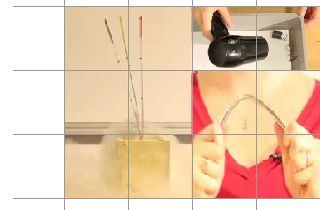
LDP Library
Lecture Demonstration Packages (LDPs) contain information about short (~3-5 minutes) practical demonstrations to be carried out within a lecture, aimed at illustrating a particular point or two within a Materials Science course. They are designed as a resource for Lecturers. They include a video showing the demonstration being performed, as well as background information about preparation, safety aspects, scientific context etc.
 Cooling of bi-material strips to generate curvature
Cooling of bi-material strips to generate curvature
![]() This LDP shows how cooling of bi-material strips with liquid nitrogen generates curvature. It involves the relationship between the curvature of a bimaterial strip, the stiffness and thermal expansivities of the materials from which it is made, and the temperature change undergone.
This LDP shows how cooling of bi-material strips with liquid nitrogen generates curvature. It involves the relationship between the curvature of a bimaterial strip, the stiffness and thermal expansivities of the materials from which it is made, and the temperature change undergone.
 Crack growth in inflated balloons
Crack growth in inflated balloons
![]() This LDP looks at crack propagation in inflated balloons. It covers the basics of fracture, stress Fields in Internally Pressurised Cylinders and the Griffith Treatment of the Energetics of Crack Propagation.
This LDP looks at crack propagation in inflated balloons. It covers the basics of fracture, stress Fields in Internally Pressurised Cylinders and the Griffith Treatment of the Energetics of Crack Propagation.
 Deformation twinning in low symmetry metals
Deformation twinning in low symmetry metals
![]() This LDP is centred on tin cry phenomenon, the characteristic sound heard when a bar of tin is bent. It is based on twinning, which is common in structures of low crystallographic symmetry.
This LDP is centred on tin cry phenomenon, the characteristic sound heard when a bar of tin is bent. It is based on twinning, which is common in structures of low crystallographic symmetry.
 Thermally induced recovery of the shape of a spring
Thermally induced recovery of the shape of a spring
![]() A NiTi shape memory alloy is experimentally observed during deformation and consequent heating. It also includes a general explanation of the Shape Memory Effect phenomenon and its ?training? process.
A NiTi shape memory alloy is experimentally observed during deformation and consequent heating. It also includes a general explanation of the Shape Memory Effect phenomenon and its ?training? process.
 Work hardening in metallic polycrystals
Work hardening in metallic polycrystals
![]() This practical introduces the effect of work hardening in polycrystal metals, in the form of bending a copper rod. To understand work hardening in the copper bar, it is necessary to understand the creation of dislocations, their gliding and interactions.
This practical introduces the effect of work hardening in polycrystal metals, in the form of bending a copper rod. To understand work hardening in the copper bar, it is necessary to understand the creation of dislocations, their gliding and interactions.

